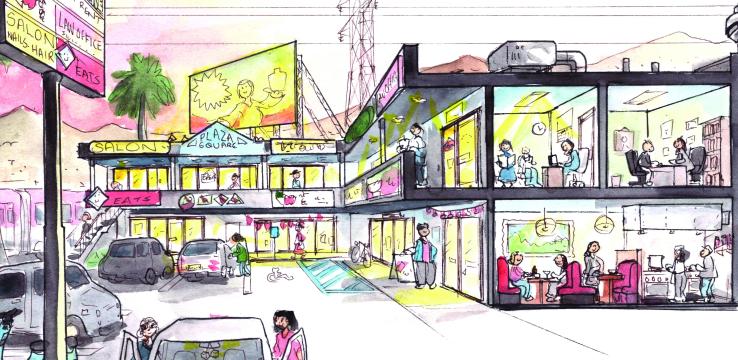By Benjamin Schneider
Illustrations by Alfred Twu
If California is “one of the prisms through which the American people, for better or worse, could glimpse their future,”1 the state also remains “an anomaly, a freak, the great exception among the American states."2
Kevin Starr and Carey McWilliams, two of California’s greatest chroniclers writing half a century apart, are both right. California has long been recognized as both a trendsetter and a wacky outlier. So it goes for California’s urbanism, the landscape that humans have constructed atop nature’s bounty.
But California urbanism is also a lived dream world. To residents, the Golden State’s built environment is simply home, as beautiful as it is often infuriating. To everyone else, California might be the most heavily mythologized landscape in existence: the pools and palm trees of music videos and reality TV, the garages where nerds create the future, the freeways and subdivisions coursing with Tarantino’s kinks and Didion’s neuroses.
Amidst this swirl of real and imagined consciousness of place, comparatively little has been said about California urbanism as one of the state’s major contributions to the world, as a work of art and engineering, as a script of history. Like the piazzas of Italy, the brownstones of the American Northeast and the neighborhood shrines of Japan, the cities of California are chock-full of local forms — missions, urban stairways, Googie architecture, Eichler homes — that embody an exceptional local culture. Our cities are also the source of pioneering forms — fast food restaurants, strip malls, food trucks, theme parks, homeless encampments — that have, for better or worse, become major elements of California’s urban identity while being copied around the world. And then of course there are those forms, or in some cases, forces, of nature that have shaped California urbanism more than anything humans have built.
These spatial and physical tropes form a distinctively Californian urban experience that goes virtually ignored, despite their role in so many problems that plague the state. A housing crisis, beleaguered transportation systems, a poorly distributed economic boom, chronic water shortages, supercharged fires and rising seas are squeezing more people onto less land and forcing us to reevaluate how that land is designed and allocated. There has never been a better time to parse out the uses and meanings of the physical spaces we inhabit, to determine what we want to preserve and what might need to change.
Luckily, there is so much knowledge written on the land. Much of it comes from our mistakes — racism, environmental degradation, designing and planning around the car. But the bones of our cities and towns hold the potential to host more equitable and sustainable communities, and their histories remind us what the California spirit can accomplish.
The five entries below represent the beginnings of my project to catalog the phenomenon that is California urbanism, one trope at a time.
Freeways
There are freeways — far too many of them— in most every American city. But perhaps only in California have they been understood as a part of the natural landscape. Freeways are, according to critic Reyner Banham’s spatial typologies, the “fourth ecology” of Los Angeles, in addition to the beaches, basins and foothills. Maria, the protagonist of Joan Didion’s Play It as It Lays, even takes to the freeway as a form of therapy, driving ”it as a riverman runs a river, every day more attuned to its currents, its deceptions.”
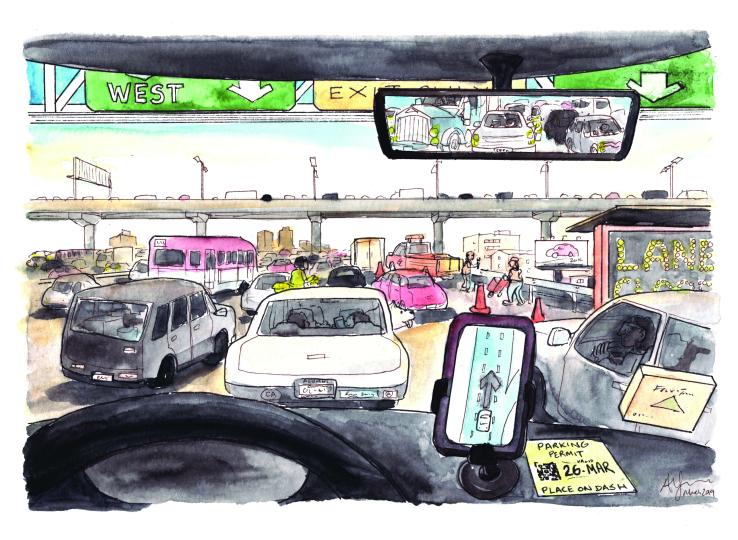
The freeway, so named not for being toll free but for being free of obstructions, has long resonated with California’s culture of personal freedom and reinvention, while also serving as the perfect setting for the ennui that stems from these unlimited horizons.3 In that sense, too, it feels like a natural extension of the landscape. Of course, where the freeways actually got built had less to do with nature than with power.
California wasn’t the first state to copy the freeway concept from Germany’s autobahn (that honor goes to New York and its “master builder,” Robert Moses), but it was an early and enthusiastic adopter. Southern California’s abundance of oil and its low-density sprinkle of retirement communities and streetcar suburbs made it an ideal use case for freeways, starting in the early 1940s with the portion of the Hollywood Freeway over the Cahuenga Pass and the Arroyo Seco Parkway. The 1939 report “A Transit Program for the Los Angeles Metropolitan Area” from a nongovernmental group called the Transportation and Engineering Board envisioned 600 miles of freeways crisscrossing Southern California. Much of the plan was executed between 1955 and 1975 by Caltrans, which for much of that period was legally mandated to choose “the most direct and practical location” for every freeway. It was not long before Los Angeles became a great big freeway, at the price of the displacement of some 250,000 people across Ventura, Los Angeles and Orange counties.
While largely Hispanic East L.A. became a tangle of six freeways, wealthy white areas, including Laurel Canyon, Beverly Hills and Malibu, mounted successful campaigns in the 1960s to fight off freeways. By the mid-’70s, when California expanded its environmental review process, the number of new freeways constructed across the state had slowed to a trickle. It turns out that when people have a say, they don’t appreciate heavy air pollution in their neighborhoods and mass displacement.
San Francisco discovered the detrimental effects of these rivers of concrete much earlier, halting nearly all freeway construction in 1959 — but only after throughways had been built to cut through Bayview, SoMa and the Western Addition. The city went on to become a freeway leader in another respect: by taking the roadways down. Following the 1989 Loma Prieta earthquake, and four competing ballot initiatives, the city rebuilt its Central and Embarcadero freeways as street-level boulevards. The eminently humanistic results helped spark a global freeway-removal movement that is still gaining steam, most recently with the removal of the Seattle viaduct earlier this year.
Building new freeways through already developed neighborhoods is not a viable option in today’s policy circles, as evidenced by Caltrans’ recent decision not to extend the 710 to Pasadena after years of citizen outcry. Excepting a planned link between Lancaster and Victorville, no new freeways are being planned in the state, although the Sisyphean urge to expand existing ones seems insatiable. With most new transportation projects in California coming in the form of non-car infrastructure, the predictions set out in the 1939 Los Angeles Transit Program just might come to fruition. Freeways, the plan reads, are an important “intermediate stage” in the region’s transportation network development, but “the ultimate solution of the rapid transit problem in a large and densely populated area can be found only in rail rapid transit.”4
Strip Malls
Like Bob’s Big Boy and Baskin-Robbins, the strip mall made its debut in Glendale. Ye Market Place, which opened in 1924, was the first “drive-in market,” according to retail historian Richard Longstreth. A major departure from the region’s traditional taxpayer-style commercial building — simple one- or two-story structures that came right up to the property line — Ye Market Place was U-shaped with a parking lot in the middle. The market’s developers also subverted prevailing wisdom by locating on a popular auto, rather than streetcar, route and in a sparsely populated neighborhood. In fact, the drive-in market was based not on existing retail store design but on “super service stations,” early auto-care centers with facilities for different maintenance needs facing a central parking lot. “The automobile is a convenient shopping basket,” one drive-in market ad proclaimed.5
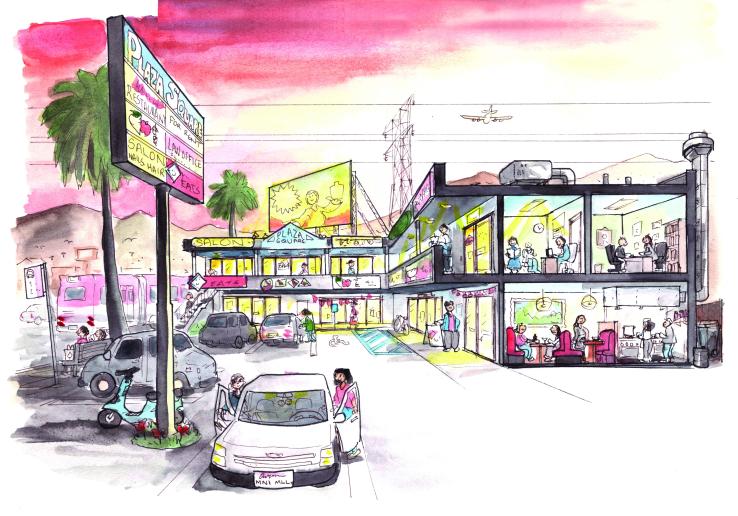
As car use grew, so did the drive-in market concept. By the late 1920s, a dozen such structures were being built across Los Angeles every month. In keeping with local tastes, many were designed with exotic embellishments, like Mandarin Market in Hollywood. More typical design features like towers and an L-shaped layout evolved for maximum visibility from passing cars, anticipating the Googie architecture and super-sized signs that sprung up around midcentury freeways. As a “machine for selling,” the drive-in market became the muse of some of America’s early modern architects, like Richard Neutra and Frank Lloyd Wright Jr., who tested their theories of functionalism in drive-in market concept drawings.
In the postwar years, the regional mall — pioneered in Southern California with the Broadway-Crenshaw Center (now Baldwin Hills Crenshaw Plaza) — came to replace the neighborhood-serving drive-in market as the dominant new retail space. Then, in the 1970s, the drive-in market was resurrected in the form of the mini-mall. With numerous gas stations shuttered due to multiple oil crises, minimalls (also called convenience centers) were a cheap and fast way for landlords to convert their commercial lots to a more lucrative use. Demand for these commercial spaces was often filled by immigrants from Asia and Latin America, who were driving California’s population growth. The donut shop, the laundromat and wilting shrubs quickly became icons of this not-so-new retail space. By the late ’80s, mini-malls had become so ubiquitous as to inspire bans on new construction in some wealthy Southern California towns. Negative perceptions only increased when 30 minimalls were destroyed during the Los Angeles riots after the beating of Rodney King in 1992.6
But the mini-mall has persevered as a hub of immigrant culture: Vietnamese in Irvine, Filipino in Daly City, Salvadorean in Pico Union. Inevitably, in recent years this aura of authenticity has garnered more mainstream (white) appreciation, as seen in articles on strip mall dining in Los Angeles from the New York Times and GQ.7 At least one obituary for Jonathan Gold, food critic for the Los Angeles Times, was titled “Poet of the Strip-Mall Eatery.”8 Long pilloried for lacking an identity, the mini-mall is now where the globetrotting, Instagram posting, disposable-income-spending urban dweller can go to find authenticity.
Missions
For many Californians, the missions are indelibly associated with fourth grade, the year that public school students are taught California history. By the time one reaches adulthood, memories from this time of life are inevitably muddled. The same goes for the state’s collective memory of the missions — especially the way that memory has manifested in the built environment.
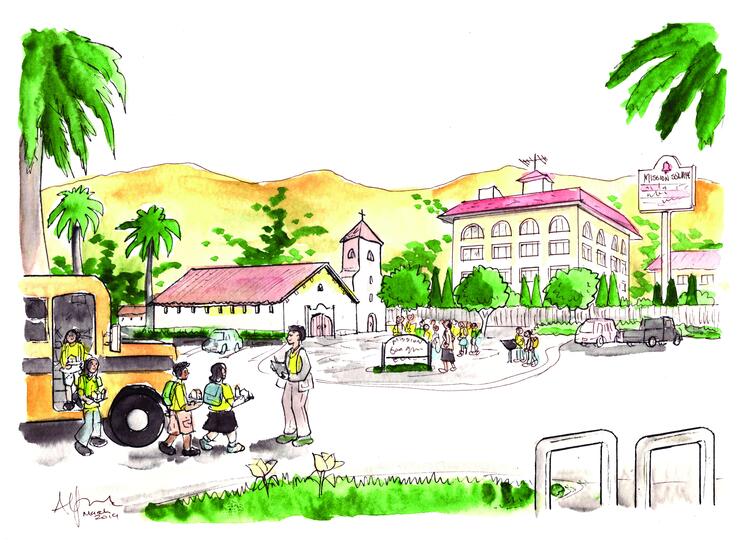
California’s 21 missions, strung a day’s horseback ride apart from San Diego to Petaluma along El Camino Real, were founded by Franciscan friars sponsored by the Spanish government between 1769 and 1823. Missions were sited near natural resources and existing Native populations, and would subsequently form centers for future urbanization.9
The missions gradually fell into disrepair and were largely ignored until the 1880s, when their ruins inspired romantic visions of old California from writers like Bret Harte and Helen Hunt Jackson. “It was a picturesque life,” Jackson wrote in her 1884 bestseller, Ramona, “with more of sentiment and gayety [sic] in it, more also that was truly dramatic, more romance, than will ever be seen again on those sunny shores.” Jackson’s tragic love story of a half-Irish, half-Native American girl and a Native American boy is set during the early statehood era but also includes similarly gooey descriptions of mission life.10
If paradise had been lost, real estate boosters would find it once again. Jackson’s hit novel coincided with a revival in colonial architecture across the nation. With the rediscovery of the missions, California had its own architectural vernacular to return to and a heroic past to sell to the visitors and transplants arriving on newly constructed rail lines. The booster/activist Charles Fletcher Lummis, who organized the first mission preservation society, wrote that the missions “are worth more money, are a greater asset to Southern California, than our oil, our oranges, or even our climate.”11
In this spirit, the Mission and Spanish Revival styles went on to dominate California architecture for decades, with their red-tile roofs, bell towers and faux-adobe exteriors. While many of these elements did come from the missions and other original Spanish buildings, the way they came together was distinctly American. For instance, the Monterey Colonial house, the prototype of the Spanish style house in California, was invented by an American businessman, Thomas Larkin. Notable examples of the Mission Revival style include the California Quadrangle in San Diego, the Examiner building in San Francisco and the Stanford University campus, which the school’s founding president, David Starr Jordan, likened to “the architectural motive of the Franciscan missions strengthened and suited to the needs of another mission equally hallowed in its purposes.”12
But how hallowed was the mission of the Franciscans? Carey McWilliams describes their outposts as “picturesque charnel houses” whose friars functionally enslaved Native Americans and kept them in concentration-camp-like conditions.12 The depictions of mission life in Ramona and so many other 19th- and early 20th-century accounts were fairy tales that were all too readily made concrete.
While undeniably beautiful, downtown Santa Barbara, the California Quadrangle and so many suburban subdivisions are descendants of an imagined history that obscures California’s original sin. The reappropriation of the missions demonstrated that this was a land where reality could be reinvented. In his description of the economic importance of the missions, Charles Fletcher Lummis wrote, “A man is a poor fool who thinks he can do business without sentiment.”14 Californians took that advice and built a modern state on it.
Japantowns
A tourist guidebook might argue that the best way to experience Japanese culture in the U.S. is to head to the mall. And it’s true that malls like the Japan Center Mall in San Francisco and the Little Tokyo Galleria and Weller Court in Los Angeles are the commercial hearts of California’s largest Japantowns. But Japanese American spaces in California have not always been defined by malls, nor have they always been in dense central-city neighborhoods like San Francisco’s Japantown or Los Angeles’s Little Tokyo. A 2007 study identified 43 historical Japantowns across California, from fishing communities in Monterey and Terminal Island to agricultural enclaves in Lodi and Santa Maria to urban neighborhoods in Sacramento and Oakland. San Francisco, Los Angeles and San Jose contain the only major areas of traditional Japanese settlement remaining in California.15
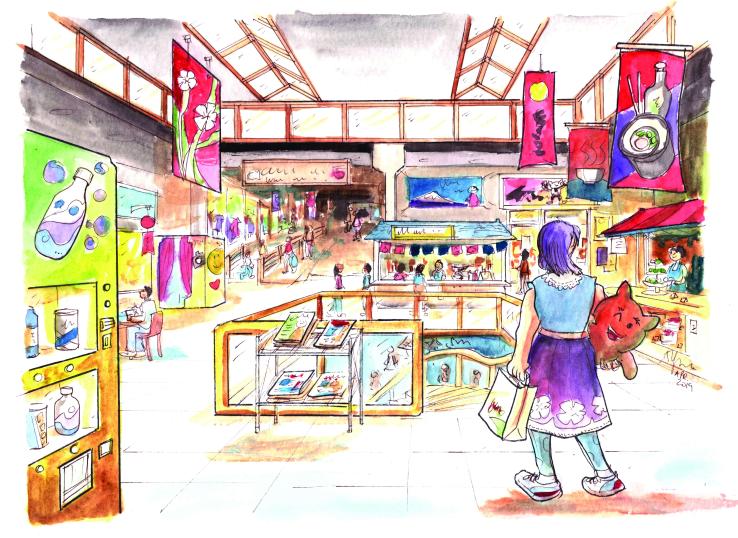
As with other immigrant enclaves in the 19th and early 20th centuries, Japantowns developed out of a combination of racist policies and a desire on the part of the immigrants to retain a traditional way of life. Before World War II, Japanese Americans were more integrated than Chinese Americans, leading to more significant geographic dispersal and the gradual depopulation of Japantowns. Then, following President Roosevelt’s 1942 executive order authorizing the incarceration of all individuals of Japanese heritage, Japantowns across California became ghost towns virtually overnight.16
In a booming wartime economy, these neighborhoods didn’t remain vacant for long. “Alien land laws” had prevented most Japanese Americans from owning property, and their white landlords were eager to fill the newly empty units.17 Japantowns were among the few neighborhoods where African Americans, who were migrating to the Bay Area and Southern California in huge numbers to fill new defense jobs, were welcome. Segregation created extremely overcrowded conditions: The population of Little Tokyo, called Bronzeville by the black community, grew from 30,000 before World War II to 80,000 at the war’s height. Bronzeville rivaled historic South Central as a hub of L.A.’s black cultural life, playing host to jazz clubs and breakfast clubs that featured the likes of Charlie Parker and Duke Ellington.18
Upon returning home from incarceration, Japanese Americans found little room left in their former enclaves. In 1947, there were only 150 Japanese American businesses in San Francisco’s Japantown, down from 450 before the war. By 1950, the neighborhood’s population was 16 percent Japanese American and 34 percent African American, according to Meredith Oda’s extensive history of the neighborhood.19
Meanwhile, Japan, only recently a mortal enemy of the U.S., was setting in motion its “economic miracle.” In the late ’50s, Justin Herman, head of San Francisco’s Redevelopment Agency and a self-described “Nihonophile,” announced his intention to redevelop Japantown to reflect the “fortunate status San Francisco enjoys as a major American gateway to and from Japan.”20
The resulting Japanese Culture and Trade Center (later renamed the Japan Center Mall), dedicated in 1968, was the centerpiece of the city’s A-1 redevelopment, which bulldozed many of the blocks abutting Geary Street through the Western Addition and displaced 2,700 families. The project fulfilled Herman’s goals for transnational collaboration: It was financed in part by Kintentsu, a Japanese rail subsidiary based in San Francisco’s then-sister city, Osaka, and designed by Japanese American architect Minoru Yamasaki.
Many Japanese American merchants and residents greeted the new building, and the social acceptance it conferred, with pride. But it made others queasy, including one young Japanese American man who told a news reporter at CBS-5 that the new mall “puts our culture on display for sale.”21 The long, windowless wall of the mall facing the new Geary expressway also created barriers between the African American and Japanese American communities, the latter rapidly departing the neighborhood that had been rebuilt in their honor while the former braced for a second wave of disruption and displacement with the A-2 redevelopment that would consume the rest of the Western Addition.22
Not to be outdone, Los Angeles embarked on the redevelopment of its Little Tokyo. This project produced similar conflicts between the Japanese American community and powerful Japanese interests. A Honolulu-based Japanese business magazine argued in favor of full-scale redevelopment, claiming that the current form of the neighborhood provided “an atmosphere far from the modern mammoth Tokyo” and that “all visitors from Japan find the place rather humbling.” But locals were more concerned with displacement than with the global stature of Japanese society: “Long and arduous struggles of our forefathers are about to be cast aside brutally by the profit-seeking newcomers from Japan,” one activist said. Another anti-redevelopment group invoked the pain of incarceration, writing in a pamphlet, “[P]eople who have continually resided in Little Tokyo, once again, are faced with the distinct possibility of mass evacuation.”23
Today, few Japanese American residents remain in either Japantown or Little Tokyo, but both are cultural hubs for the Japanese American community, complete with temples, museums and quirky shops and restaurants — some street-facing, some in malls. (Both also serve as Instagram-friendly destinations celebrating the current cultural obsession with all things Japan, from ramen to Hello Kitty.) But as historical monuments, they say more about midcentury urban political economy than they do about the Japanese American experience (or the African American experience, for that matter). They are, among so many other things, time capsules to the ’60s and ’70s, when the state’s power players aspired to be the “Gateway to the Pacific” and when malls were seen as the de facto space for commerce and culture.
Office Parks
For most of the past half-century, Silicon Valley has been the quintessential “nerdistan,” an archipelago of nondescript low-slung office buildings in an ocean of parking.24 This was the architecture of the innovation economy, where aesthetically agnostic coders and companies scuttled from office park to office park like hermit crabs. Then the internet became the social web, and tech companies wanted to be cool. As traffic worsens in Silicon Valley and the center of the tech universe is moving to San Francisco, the office park is looking more and more like an anachronism.
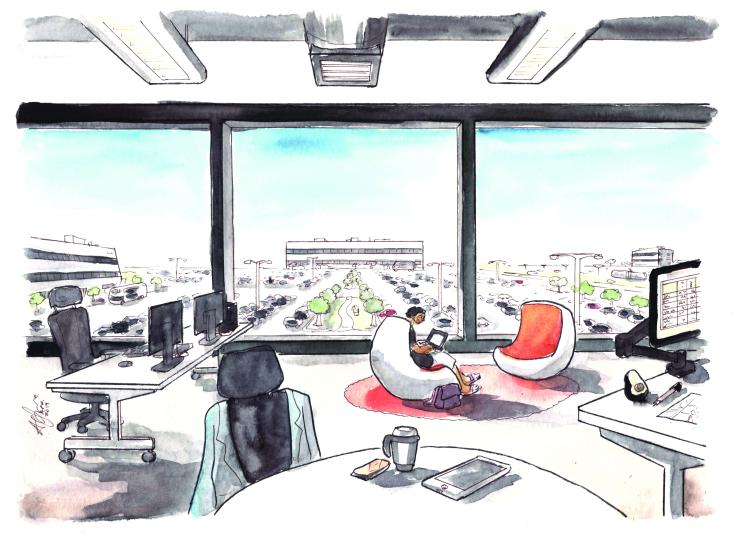
For a long time, though, office parks were a symbol of the technological cutting edge. Stanford Industrial Park, founded in 1951 and later renamed Stanford Research Park, was the product of a unique collaboration between the university, the City of Palo Alto and the firms that set up shop there. Its existence is inseparable from the financial and institutional models that built Silicon Valley. As the brainchild of Frederick Terman, a Stanford electrical engineering professor and administrator who helped his students William Hewlett and David Packard get their first business loan, Stanford Industrial Park made concrete the close relationship between the academy and high-tech business.25
In their architecture, too, early Silicon Valley office parks captured the countercultural ethos of the burgeoning tech sector. Unlike the “corporate estates”26 that sprung up in East Coast suburbs at midcentury, California’s office parks were characterized by wide open floor plans that testified to a laid-back, nonhierarchical business culture. Buildings were drab and unadorned, which enabled the flexibility of rapid up or downscaling and allowed hot new firms to seamlessly take the place of yesteryear’s leading company. In Web 2.0, a new paradigm emerged when some major tech companies eschewed that generic approach in favor of glossy monuments designed by starchitects like Frank Gehry (Facebook) and Sir Norman Foster (Apple). Inside these structures, a type of urbanism ensues: Colleagues from different departments have chance encounters; ideas move quickly from the rank and file to the nonexistent c-suite; employees bond while enjoying an ever-increasing array of amenities like free food, doggy day care and wellness centers.
But if office parks promote urbanism within, they prevent urbanism without. Those massive open floor plans, like the nearly half-mile-long “horizontal skyscraper” at Bishop Ranch in San Ramon, make walking difficult and unpleasant. That is, if there’s anyplace to walk to. If you survive the journey across the massive parking lot and multilane roads, odds are good that it’s a long way to the nearest restaurants, stores, schools and transit stations. The traffic and environmental problems associated with office parks are self-evident.
Yet the office park remains a powerful symbol of the California economy. Aspiring Silicon Valleys around the world, from Bangalore to Nashville, tap into the Silicon Valley tradition of architecture to try to re-create the alchemy that made the region a metonym for the new economy.27
The irony is that in the real-life Bay Area, many people don’t want to work in office parks. Instead, marquee companies are going for edgy postindustrial buildings, like Airbnb’s headquarters at a former battery factory, or vertical campuses like Salesforce and Yelp. The Bay Area’s tech shuttles are a testament to both the poor transportation options available to office park workers and the desire of said workers to live far from these environments. In California — and across the world —talent-hungry companies are rushing to expand their presence in downtowns, where amenities, mass transit, leisure opportunities and nearby housing options come standard.
And in the Web 2.0 era, the whole notion of architecture is shifting. Whereas the hermit crab model of undifferentiated office parks highlighted the primacy of a firm’s digital architecture in cyberspace, today’s leading companies are dependent on the physical architecture of urbanity.28 Airbnb, Uber, Square and Yelp are platforms for urban life. No wonder they are all headquartered in dynamic urban neighborhoods.
Silicon Valley’s preeminence has turned it from a place of ephemeral companies and disposable workplaces to the home of some of the world’s most powerful institutions, deeply rooted in place. With the marked exception of Apple in Cupertino, many tech giants are urbanizing their headquarters, like Google’s housing push in Mountain View and Facebook’s new Willow Campus in Menlo Park.
But for those not employed by a unicorn, the traditional office park is still very likely where the work is. More than 80 percent of jobs in the Bay Area are more than half a mile from regional rail lines like BART and Caltrain, SPUR found in its recent report Rethinking the Corporate Campus. The ability to escape nerdistan is a great privilege, the report noted: “Urbanism has turned into a scarce resource, available largely to those on the winning side of uneven prosperity.”29
Another way to look at it: All of those parking lots are just urbanism waiting to happen.
Endnotes
1 Kevin Starr, California: A History, Random House, 2005.
2 Carey McWilliams, California: The Great Exception, UC Press, 1949.
3 David Brodsly, LA Freeway: An Appreciative Essay, UC Press, 1983.
4 “A Transit Program for the Los Angeles Metropolitan Area,” Los Angeles Transportation and Engineering Board, 1939.
5 Richard Longstreth, The Drive- In, the Supermarket, and the Transformation of Commercial Space in Los Angeles, 1914–1941, MIT Press, 1999.
6 Mary Melton, “A Brief History of the Mini-Mall,” Los Angeles Times Magazine, November 16, 1997.
7 Tien Nguyen, “about los angeles,” published on Medium, December 21, 2016, https:// thepiesinthesky.com/about-losangeles- 825b8f81861d
8 “Jonathan Gold, poet of the strip-mall eatery,” The Economist, July 26, 2018.
9 Sally Woodbridge, foreword to The Missions of California, Chronicle Books, 2004.
10 Woodbridge, foreword to The Missions of California.
11 Harold Kirker, California’s Architectural Frontier: Style and Tradition in the Nineteenth Century, Gibbs Smith, 1960.
12 David Starr Jordan, “The Ideals of Stanford University,” Overland Monthly, September 1902.
13 Carey McWilliams, Southern California: An Island on the Land, Gibbs Smith, 1946.
14 Kirker, California’s Architectural Frontier.
15 Donna Graves and Jill Shiraki et al., “Preserving California’s Japantowns,” sponsored by the Japanese American Community Leadership Council, 2009, https:// www.californiajapantowns.org
16 Meredith Oda, The Gateway to the Pacific, University of Chicago Press, 2019.
17 Cherstin M. Lyon, “Alien Land Laws,” from Densho Encyclopedia, http://encyclopedia.densho.org/ Alien_land_laws/.
18 Martha Nakagawa, “Little Tokyo/Bronzeville, Los Angeles, California,” from Densho Encyclopedia.
19 Oda, The Gateway to the Pacific.
20 Oda, The Gateway to the Pacific.
21 Lynne Joiner, CBS-5 KPIX-TV, September 9, 1974, https://diva. sfsu.edu/collections/sfbatv/ bundles/190408.
22 Oda, The Gateway to the Pacific.
23 Miya Shichinohe Suga, “Little Tokyo Reconsidered: Transformation of Japanese- American Community through the Early Redevelopment Projects,” the Japanese Journal of American Studies, no. 15., 2004.
24 Joel Kotkin, “Escape from Nerdistan,” Washington Post, September 14, 1997
25 Gwendolyn Wright, “The Virtual Architecture of Silicon Valley,” Journal of Architectural Education, vol. 54, November 2000.
26 Louise Mozingo, Pastoral Capitalism: A History of Suburban Corporate Landscapes, MIT Press, 2017.
27 John C. Stallmeyer, “New Silicon Valleys: Tradition Globalization and Information- Technology Development in Bangalore, India,” Traditional Dwellings and Settlements Review, vol. 19, Spring 2008.
28 Wright, “The Virtual Architecture of Silicon Valley.”
29 SPUR, Rethinking the Corporate Campus, April 2017.

